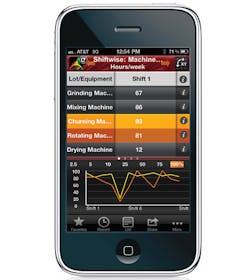When Invensys Operations Management (IOM) set out earlier this year to develop an industrial "app" for smart phones, the company had a strong idea of what it wanted to do. IOM, the Plano, Texas-based automation supplier, partnered with Sarla Analytics LLC, Barrington, R.I., a supplier of smart phone applications, to develop SmartGlance, a software-as-a-service offering designed to deliver manufacturing intelligence data to smart phones, including Apple iPhones, Apple iPads, Blackberries and Android models.SmartGlance was introduced in October. But before Invensys brought the SmartGlance offering to market, it turned to its customer council, a group of both large and small users of its products, for input on the app's features and functions. "We started working with them very early on, asking what kinds of information would be most useful, and how they would want to see it," says Rob McGreevy, IOM vice president, platforms and applications. One customer, in particular—General Mills—stepped up to provide significant guidance and feedback, McGreevy notes, driving "some very important changes" in the app's design.First lookGeneral Mills got its first look at the SmartGlance app early last summer, says Chris Damsgard, senior engineer at the company's Controls and Information Systems Engineering Group, in Golden Valley, Minn. "Their first pass was on the iPhone. They could show some tabular data and they could do some charting, but that was about it," recalls Damsgard who does much of General Mills usability work. "So we started thinking about the problems that we have in the manufacturing space and how a mobile app could help us solve those, and we started explaining some of those challenges and problems to Invensys." The vendor responded positively, making appropriate changes to the app, he says. One thing that was missing in the early SmartGlance implementation was an alerting function, Damsgard says. While Invensys had started with a "great idea" of delivering real-time manufacturing data via smart phones, "they weren't really totally catching the use case"—that busy manufacturing users don't have time to be constantly checking or staring at their smart phones, he explains.Other suggestions made by General Mills included the use of color to highlight trouble spots in the data; the ability to automatically notify other users who should be alerted when particular problems occur; and the integration of workflow instructions to guide users through needed problem-resolution steps. All are in various stages of implementation, or in plans for future iterations of the SmartGlance offering, IOM's McGreevy indicates.To see a video interview and demonstration of SmartGlance with Bimal Mehta, Director, Industry Application Management, for Invensys Operations Management, please visitwww.automationworld.com/video-7750.One colorSometimes, the optimal display approaches weren't immediately obvious. When General Mills suggested use of color, for example, the SmartGlance developers quickly thought of using red, yellow and green to indicate varying levels of equipment health. But General Mills instead pushed for just a single color to be used—and only when an anomaly occurs. The red-yellow-green approach would have produced too much visual noise, requiring users to interpret all of the different colors, Damsgard explains. "Why not assume that things are good and shade just the one thing that I need to pay attention to?" he says. "When I open my report, I've got this grid of numbers, and I need to be able to go straight to the one that's messed up, because at that moment, that's all I care about, so that's what the single color accomplishes."Another important capability for General Mills is the ability of the SmartGlance app to be configured by each individual user. Early versions of SmartGlance had somewhat rudimentary configurability features, says Damsgard. "We could have taken what they had off-the-shelf, and we would have spent a considerable amount of time coming up with three or four reports, hard-coded, for a very specific audience. And that would have been okay for that audience," he notes. "But it would have been very hard to grow beyond that."Instead, Damsgard is working directly with the SmartGlance developer to integrate the General Mills Manufacturing Metrics data model, which incorporates about 4 million measurement points covering some 35 to 40 North American plants. "We want our users to be able to navigate this entire space and be able to pick out the exact metrics that they care about," Damsgard says. And when users' data needs change, they should be able to easily and quickly reconfigure the data sets that their smart phones deliver.PayoffsDamsgard anticipates significant payoffs for the project. Even a minute of downtime can amount to large costs for General Mills, he notes, "so the sooner you can get the information into somebody's hands, the sooner they can react to prevent losses," he says. At press time, Damsgard was hoping to begin piloting the SmartGlance app with General Mills users by around the end of November.
Subscribe to Automation World's RSS Feeds for Feature Articles
About the Author
Wes Iversen
Managing Editor
Sign up for our eNewsletters
Get the latest news and updates

Leaders relevant to this article:
